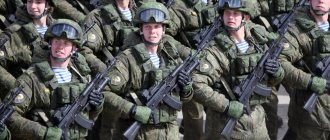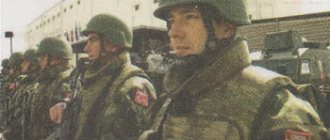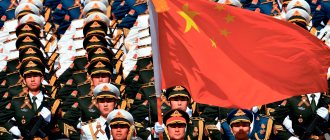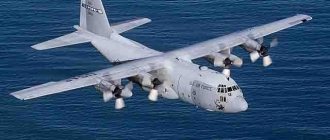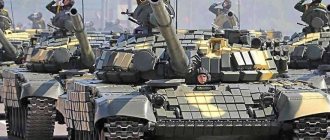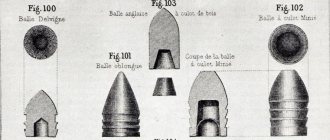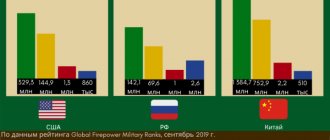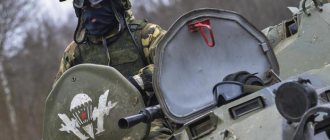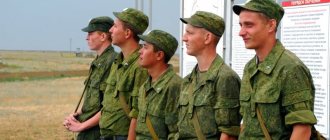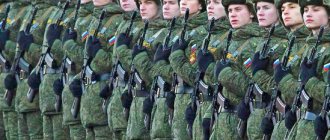The Finnish Army or Finnish Defense Forces are the armed forces of the Republic aimed at protecting the country's sovereignty. They include several branches of the military: naval forces, air force, ground forces and special forces.
It must be said that for many Finns, serving in the army is prestigious, because here they are more willing to hire those who have completed military service. And if a person was drafted into the army from work, then upon returning home he will receive his previous place.
In the army, conscripts study military affairs, weapons, martial arts, visit gyms and develop themselves physically, and also work intellectually, for example, studying the latest types of weapons and military equipment.
Let us note that there is no hazing in the Finnish army; at the slightest hint of this, a person showing negativity towards his colleagues will have serious problems. Before taking a person into the army, he goes through doctors, because they only take really physically healthy people.
Army history
Throughout their history, the Finns have been a rather warlike people. Which is not surprising - after all, their neighbors were Scandinavians and Russians. And armed conflicts constantly occurred with these peoples.
For some time after joining the Russian Empire (in 1809), the army was absent here as such. Therefore, the beginning of the armed forces of Finland as an independent state was laid only in 1918 - exactly 100 years ago.
After that, she had to undergo a baptism of fire in a battle with a truly formidable enemy - the USSR. The war lasted six months - from the autumn of 1939 to the spring of 1940. Of course, Finland could not help but lose. However, she demonstrated a high military spirit.
A year later, the country had the opportunity to pay for its grievances - it sided with the Third Reich and took an active part in the war against the Soviet Union. True, in 1944, when the front line shifted to the west, Finland had to make peace with the enemy - the Moscow Armistice was signed, according to which the country left the war.
After this, the history of the Finnish armed forces can no longer boast of bright moments and exploits. Although the Finns took part in UN peacekeeping operations, they were no longer distinguished in major battles - after leaving the Second World War (which was almost three-quarters of a century ago), the army lost less than fifty soldiers and officers.
The Finnish Armed Forces are called upon to develop their combat capabilities
The new defense report makes clear that defense forces must be developed in a new way, but must be maintained and renewed in the same way. The main areas of building our defense capability are combat readiness, replacement of obsolete capabilities, intelligence and information superiority, as well as cyber defense and precision weapons. Finland's defense system will be developed in such a way that there will be no practical obstacles to possible membership in any military alliance.
Despite the change in the operational environment, Finland is not currently exposed to an immediate military threat.
However, multidimensional threats emerge quickly and unexpectedly and can have serious consequences. This makes it necessary to expand our operational readiness and adapt it flexibly to meet needs. Until now, the Finnish Air Force and Navy controlled and protected the territorial integrity of the country. In the current operational environment, we are improving the operational readiness of the Air Force and Navy.
Hanima type boats of the Finnish Navy
In the ground forces this change is being implemented much more noticeably. We are turning this branch of the armed forces, which previously focused on training, into a duty and training structure. This means, for example, the formation and training of new military units of high operational readiness. In accordance with the recommendation of the defense report, from 230 to 280 thousand people. The total number of defense forces is increasing.
The Finnish Armed Forces intend to expand its defense capabilities in the long term. Limited financial resources, at the same time, hinder the simultaneous development of all areas. Therefore, purchases of major weapons systems in the long term will receive priority and be distributed among different types of armed forces. The goal is to maintain a balanced overall combat capability.
Self-propelled howitzer K9 of the Finnish ground forces
In 2022, the main focus was on the development of the ground forces. The armament and combat capabilities of their units are becoming more advanced from decade to decade. The most important projects for the ground forces are improving their mobility, quick response, and firepower. An example of such work is the purchase in 2022 from South Korea of a K9 self-propelled howitzer for Finnish artillery, one of the largest in Europe. Thanks to systematic development, the combat capabilities of the Finnish ground forces are guaranteed even after 2020. The total volume of acquisitions planned for the Navy in the next decade will be almost three times the cost of the Navy's Squadron 2020 project (Squadron 2020).
On the other hand, the development of the Navy and Air Force is reflected in the procurement of systems such as ships and aircraft. Major systems of the Navy and Air Force will be decommissioned almost simultaneously in 2020. For our defense, the procurement of ships and fighters that will replace existing systems by the beginning of the next decade is a very important strategic project. Squadron 2020 will replace seven Navy ships after their operational period ends. This project is a prerequisite for guaranteeing maritime defense from the middle of the next decade. The new multi-role fighter, as a replacement for the current F/A-18 Hornet, will allow us to protect our airspace and maintain our preventive defense capability into the future.
Finnish Air Force F-18 fighter
Implementation of the defense report's directives requires sufficient resources. To implement them, the document names three closely interrelated financial instruments. They focus on operational readiness, strategic projects and procurement.
An additional €50 million has been allocated to improve operational readiness. This ensures our ability to continuously respond to all types of military threats. Financial resources for strategic projects must be allocated not from the material budget of the Armed Forces, so as not to lead to the destruction of the entire structure, such as our current defense system. On this basis, strategic projects are to be financed from separate sources. The relevant decisions are important at the national level. In addition, additional funds in the amount of 15 million euros are guaranteed for the further development from 2022 of the combat capabilities of the ground forces, as well as the general capabilities of all types of armed forces.
Number today
Now let’s fast forward to the present and first of all we’ll talk about the size of the Finnish army.
In general, the country's armed forces are quite developed, although not too numerous. They consist of land, naval and air forces. Special bodies, also part of the army, stand apart.
Despite numerous protests and demands to abandon conscription in the defense forces, the country's leadership continues this proven practice. Therefore, most of the Armed Forces are staffed with conscripts.
The total strength of the defense forces today is 34,000. Of these, only eight thousand are professional military personnel. Another four thousand are civil servants. The remaining 22,000 are conscripts.
According to the Ministry of Defense, if necessary, in just 2-3 days the number of military personnel can be significantly increased thanks to the mobilization of reservists - up to 340 thousand people. Quite a serious indicator for a country with a population of about five million people! Although significantly less than just twenty years ago - then the figure was about half a million people.
Finnish Navy
The Finnish fleet has bases in Turku, Kirkkonummi, Raseborg and the city of Helsinki. The Navy is an independent branch with approximately 1,400 personnel. Every year about 3,200 conscripts are called up for service.
Photo: MKFI/Wikimedia Commons
The Finnish Naval Command and four brigade-level units make up the Finnish Navy. The Naval Academy trains cadets, conscripts and specialists and is responsible for the research activities of the Navy.
Emergency service
As mentioned above, the Finnish Armed Forces are staffed primarily by conscripts. Service is compulsory for all boys over the age of 18, who are fit in health and have no relevant contraindications. The only exception is the population of the Alan Islands - people from there are not required to serve.
The service life is quite short - only six months. But if a young man does not want to join the army and prefers alternative service, then he will have to spend much more time here - a whole year. But still, many choose the second option, since it is associated with less physical and psychological stress and is not associated with danger.
Border guards are the elite of any army
Border troops in any country are the shield that bears the first blow. Therefore, their preparation and equipment are given special importance. Finland is no exception.
The number of border troops is very small - only 3,100 people. Moreover, more than half a thousand of them belong to paramilitary forces. About the same number are conscripts. But many officers have completed the training center of the Finnish Armed Forces Rovaj RVI, which is considered very prestigious.
Border guards are not officially part of the army and are not subordinate to the Ministry of Defense. They report directly to the president of the state. But if martial law is introduced, the border troops will be transferred to the armed forces. Surely many will be surprised by such a system. However, in fact, it cannot be called new and unusual.
For example, in the USSR, the border troops on the eve of the Great Patriotic War were also not part of the Armed Forces - they belonged to the NKVD of the state. The Finns appreciated the merits of this approach and completely copied it.
The technical equipment is very good for such a small number. Finnish border guards have six patrol ships, six dozen patrol boats, and seven hovercraft. They also have at their disposal two German planes and eleven helicopters - French and American production.
In general, the powers and responsibilities of border guards are quite broad and varied. In addition to the usual protection of the state border, there is a list of other goals. For example, passport control and physical training of conscripts. Moreover, they also train intelligence officers and partisans to work in the occupied territories. In addition, they are obliged to investigate any crimes related to the border. And in small settlements they also carry out customs control.
In the northern regions of the country, border guards undergo special training to carry out rescue operations.
Additionally, the rights of police officers fall on the shoulders of the border service. For example, military personnel have the right to interrogate suspects and search apartments. However, there is a certain limitation here - police powers are vested exclusively in senior military officers - from the head of the border detachment and above.
In emergency situations, border guards may be called upon to conduct police operations.
The main small arms of the Finnish border service is the local modification of the Kalashnikov assault rifle - RK 95 TP.
The security situation around Finland and the changing nature of threats
In recent years, the security environment around Finland has become unstable and unpredictable. Military activity in our neighboring areas has increased significantly compared to the situation in the first half of the decade. Russia is moving new weapons systems closer to our borders and strengthening the troops of its Western Military District.
NATO is also strengthening the defense of Eastern Europe and the Baltic Sea region by stationing troops and systems in the region on a long-term basis. Finland's neighbors are responding to security changes by improving the readiness of their armed forces, making procurement decisions and increasing funds for their armies.
In addition to the growth of traditional land, sea and air operations, information systems - the cyber dimension - are also becoming a domain of warfare. Information networks and their data allow the enemy to become more inclusive and unexpected than with conventional military means. In particular, a cyber attack can quickly paralyze several critical functions of society. Traditional and new methods of warfare can also be combined in a variety of ways.
Practicing interaction between the Finnish defense forces, police and border guards during the exercise
Today, external and internal security are intertwined and can no longer be considered separately. You cannot counter multidimensional threats based on only one resource or one actor. Global cooperation between various authorities, organizations and business entities is essential to respond to threats. The Finnish model of shared security, in which the mobilization and cooperation of authorities is clearly regulated and their interoperability is regularly practiced, provides a solid basis for responding to these types of threats.
Ground troops
Like most armies in the world, it is the Finnish ground forces that are the largest - 24,500 people serve in them. They are consolidated into four commands - on a territorial basis. They are called simply and uncomplicatedly - Northern, Southern, Western and Eastern. Each command is divided into brigades, and those are already divided into regiments. The brigade consists of about 2,300 people, 1,700 of whom are conscripts.
The Utti ranger regiment is considered part of the special forces. He reports directly to the command of the ground forces. It includes a Jaeger battalion, a supply company and an army aviation battalion.
Finland's defense capability meets security conditions
The security situation in Finland's neighboring areas has deteriorated. Military tension and uncertainty in the Baltic Sea region have increased. This does not mean that we expect war to break out. However, we must be prepared if military force is used against Finland or if we are threatened with it. Ensuring that our defense is strong is not waving a saber. It is our responsibility and a stabilizing factor for our safe environment. Our message is clear: Finland has the defense capability and readiness to match the surrounding security conditions.
The measures taken to improve our preparedness ensure that we can continue to respond to possible military threats to Finland in the future. The meaning of our actions, first of all, is to prevent threats that lead to military conflicts.
The Defense Report is published in 2022 and guidance from the leadership has given the Defense Force clear guidance for the future. Sufficient resources are a condition for the implementation of these guiding directives and therefore the legal basis for our defense capability in the next decade.
based on materials from the magazine “Europäische Sicherheit & Technik”
Aviation is the queen of the skies
It is stupid to argue about the importance of aviation in modern combat. The leadership of the Finnish army understands this very well - the Air Force is equipped with outdated aircraft, but there are quite a lot of them and they are kept in perfect condition.
Mostly American and British aircraft are used. The main striking power is allocated to 56 F/A-18C - multirole fighters. Essentially, this is a Finnish conversion of the American F/A-18 Hornet aircraft, which is produced under license. True, it was developed almost half a century ago, so, of course, it cannot compete with modern analogues. In addition, there are 58 Hawk trainers manufactured in England. Two F-27 passenger aircraft from the Netherlands are used to transport military personnel and are also part of the Air Force.
However, there are also Finnish specialists’ own developments. First of all, these are 28 Valmet L-70 and 9 Valmet L-90 Redigo aircraft. However, all of them are training and not combat.
In total, the Finnish Air Force has 121 aircraft. Very good for such a small country. The Air Force also includes 3,850 personnel.
Finnish defense: all for the sake of national security
Finnish soldiers during joint exercises with the USMC
Finland pays great attention to national security issues. Despite the limited size and capabilities of the armed forces, significant measures are being taken to ensure defense capability and maintain peace. To achieve this, an original and interesting policy is being pursued, which involves defending one’s interests using various methods, both independently and within the framework of international cooperation.
Defense Doctrine
Due to limited resources, Finland does not rely only on the Defense Forces in case of war.
Security is based on the concept of the so-called. total defense. This means that all ministries and departments have plans in case of emergencies or armed conflicts. Each organization receives certain powers for peacetime and for war. Emergency measures are put into effect by a special law - if necessary, it is introduced by the president and approved by parliament. The key provisions of the defense doctrine are the fundamental refusal to participate in any military or political alliances, organizing exclusively one’s own defense, and ensuring a flexible response to a wide range of threats. The main security threats are various pressures from third countries, including blackmail by military force, outright attack and regional conflicts potentially affecting Finland.
Land Defense Forces during exercises
In peacetime, the Defense Forces recruit and train recruits and carry out defense construction. In the event of a conflict, they must collect reservists and deploy territorial defense. The main task of the army is to keep the enemy close to the borders and protect key areas of the country. To do this, it is proposed to use tactics and strategies optimized for characteristic geographical and natural conditions.
The Defense Forces include ground forces, air and naval forces, various special forces and also border guards. During a conflict, they must act together to counter the enemy in their environments. Civilian structures and departments must ensure the work of the army by all available means.
The international cooperation
Refusal to participate in military alliances does not exclude cooperation with other countries. Moreover, in some areas such cooperation is acquiring quite remarkable proportions. Such interaction takes place in the field of peacekeeping operations and joint security programs.
Reservists and tank crews
The Defense Forces have regularly participated in international peacekeeping operations since 1956. Together with the armies of European and American states, they have worked in almost all local conflicts of recent decades. Dozens of Finnish military personnel took part in the largest operations, for example in Afghanistan or Iraq. In other cases, Finland could send no more than 6-10 observers to the scene.
Defense forces, represented by different branches of the military or individual formations, regularly participate in international exercises. For obvious reasons, most often such events involve working together with the armies of NATO countries. The maneuvers take place at Finnish and foreign land and sea training grounds.
Outside NATO
Finland has a very interesting relationship with the North Atlantic Alliance. The country's top military and political leadership has adhered to a policy of neutrality for decades and denies the possibility of joining NATO. At the same time, some political forces, incl. former leaders of the state express their opinion on the need to join the Alliance.
Soldiers of the Pori brigade at the parade
Arguments in favor of joining NATO include simplifying interaction with other countries and increasing the overall level of security. These advantages are contrasted with the principled position of military-political independence. In addition, joining the Alliance could put Helsinki at odds with Moscow, and the Finnish leadership is in no hurry to spoil relations with its closest neighbor.
However, refusal to join does not exclude other options for interaction with NATO and its individual countries. Thus, the Defense Forces are built, armed and equipped according to the standards of the North Atlantic Alliance. We have extensive experience interacting with NATO armies using their methods and strategies.
Joint Expeditionary Force
Of particular interest in this context is the participation of the Defense Forces in the so-called. United Expeditionary Force (UK Joint Expeditionary Force or JEF), formed on the initiative of NATO since 2014. In the event of a crisis or the outbreak of an open conflict, the nine member countries of the JEF, led by Great Britain, can create a single army group and solve the problems of restoring peace.
Ragnar - four-legged soldier of the Kainuu Brigade
JEF began work only a few years ago, and so far they are limited only to organizational issues and joint exercises. Finnish units, together with formations of other countries, are practicing combat on land and at sea. Exercises also took place with other NATO countries outside the JEF.
It is noteworthy that two fundamentally neutral states at once joined the Joint Expeditionary Forces - Finland and Sweden. For many decades they have been trying to invite them to NATO; The need to join the organization is defended by some internal political forces. However, the authorities of the two countries refuse to join NATO - although they have joined the “non-NATO” JEF.
Neighborhood and alliance
In the context of the future of Finnish defense doctrine, issues of the notorious Russian aggression and potential accession to NATO are emerging. At the same time, both questions do not have simple and understandable answers, and Helsinki takes a distantly neutral position and tries to seek its own benefits.
Finnish Air Force F/A-18 fighters
Due to its geographical location, Finland is of great interest to NATO. Full access to its territory and bases will give the alliance significant advantages within the framework of current strategies to combat Russia. As long as Finland remains an ally, but not a member of the organization, such benefits will not be obtained. As a result, external and internal attempts to drag Finland into NATO have been ongoing for several years - so far unsuccessful.
Formal neutrality and cooperation with the military bloc lead to certain risks. Not being a NATO member, Finland cannot count on guaranteed assistance in the event of a conflict with a third party. “Friendly” countries will decide for themselves whether they will defend Finland. These circumstances are simultaneously used as an argument in favor of joining the Alliance and as an argument against it, due to the specific position of the “allies”.
Participation in JEF can be seen as an attempt to get rid of such problems. The Joint Expeditionary Force is only a temporary alliance that works out of necessity. There are no political or military commitments of the type found in NATO. Accordingly, participation in the JEF allows Finland to count on the help of friendly states - at least in deterring potential adversaries.
Finnish fleet in exercises
Against the background of the situation around Finland and NATO, the position of the main “aggressor” of the region – Russia – looks interesting. Moscow has repeatedly spoken about its respect for Finland’s position, regardless of its participation in military blocs. However, it was noted that the entry of a neighboring country into NATO would force Russia to take the necessary measures to ensure its own security.
Own course
As we can see, Finland has its own defense doctrine, aimed exclusively at ensuring national security, but does not exclude military and political cooperation.
The geographical location leads to special risks associated both with a possible attack and with the special policies of the allies. At the same time, limited capabilities and armed forces do not allow them to even claim regional leadership. Finland strives to maintain smooth relations with all countries in its region and therefore is in no hurry to respond to NATO invitations, although it has joined the new JEF treaty. With all this, the construction of defense is carried out independently, but with the use of foreign developments and products.
It should be expected that in the foreseeable future Finland will not change its position and will remain a neutral country that does not participate in full-fledged alliances or blocs. However, she will have to fight active attempts to be drawn into such an alliance. However, Helsinki has long been accustomed to such actions by “friendly” countries and focuses on their own security rather than on the interests of other states and unions.
A few words about armored vehicles
Armored vehicles have remained a powerful argument in any conflict for decades. Therefore, the Finnish military also does not forget about high-quality equipment.
The main tank is the German Leopard 2A4 - a proven and reliable vehicle. Developed in the seventies of the last century, it is still one of the most successful tanks in the whole world.
Finnish experts also recognize the high qualities of Soviet technology. The state has 92 BMP-2s in service. Although the vehicle was developed about forty years ago, its excellent technical characteristics and high firepower make it a truly formidable weapon when used correctly.
Also, the Finnish armored forces are equipped with ten armored reconnaissance vehicles and 613 armored personnel carriers.
Who guards the sea
In total, in peacetime, the Finnish Navy has 6,700 people - of which only 2,400 are officers and contractors. The remaining 4,300 people are conscripts. All of them are divided into two commands - the first relates to the Archipelago Sea (the command is located in the city of Turku), and the second to the Gulf of Finland (Upinniemi). In addition, the Navy includes the Uusimaa brigade, consisting of marines and coastal artillery.
It cannot be said that the Finnish Navy is particularly strong - it is primarily aimed at defensive actions and creating problems for a potential enemy when entering from the sea. Therefore, the main strike power is concentrated in only eight missile boats of the Hamina and Rauma type.
But there are five minelayers, which should block the approach to the country’s coast from the sea. Thirteen minesweepers are used to combat minefields.
An interesting feature of the Navy is a large number of light fast landing boats - their main task is to work in skerry areas, of which there are many on the coast of Finland.
Global modernization
It is worth saying that the state leadership takes modernization of the army very seriously. More than 3 billion euros are spent annually on maintaining and improving the army - a very large amount for a small state.
Therefore, in the coming years, for example, American Stinger MANPADS should appear among the weapons of the Finnish Armed Forces - $127 million have been allocated for this.
Negotiations are also underway with Holland on the purchase of German Leopard 2A6 tanks, which have undergone repairs and modernization. It is planned to purchase one hundred vehicles - very serious power.
The purchase of new ships that are more in line with modern requirements is planned for the 2020s. And by the early 2030s, the Department of Defense plans to upgrade the Air Force by replacing outdated Hornet fighters.
Refusal to join NATO
Despite numerous invitations, Finland has still not become a member of NATO. First of all, the state leadership explains this decision by the fact that it does not want to spoil relations with such an influential neighbor as Russia.
In general, it is worth saying that serving in the Finnish army is not particularly prestigious. Despite large salaries even by local standards, the Armed Forces are constantly experiencing a shortage of professional military personnel. First of all, this is due to the fact that the majority of men of the once formidable and warlike people simply refuse to join the army, whose activities are associated with constant danger and serious physical exertion.
Finnish army today
Although the modern Finnish army has peaceful goals, its weaponry is at its best. They also take young people's military service seriously.
Armament
Most of the tanks in Finland are German-made. In total there are 168 of them in use by the army. There are also 196 infantry fighting vehicles, about a thousand armored personnel carriers (both modern Finnish, and from the times of the USSR and South African). Finland has some of the best artillery shells in Europe - ranking 6th in terms of quality and quantity. There are also towed guns, but most of them are of Soviet origin. There are 237 obsolete howitzers, there are Finnish-made mortars, and 158 Israeli-made Spike. Anti-aircraft weapons, transport helicopters are presented, and there is a fighter squadron.
These are just a few examples of the weapons owned by the Finnish army.
Number
The Finnish armed forces are not numerous, but they are well developed. They include air, ground and naval forces. Most of the military forces are conscripts. Many were against the defense forces being staffed in this way, but this practice currently continues.
Today, the total number of military personnel in the country is 34 thousand people. 8,000 of them have specialized military education and are considered professionals. Civil servants - 4,000 people. The rest - about 22,000 people - are conscripts.
Representatives of the Ministry of Defense assure that in the event of a military alarm, about 340 thousand military personnel can be quickly assembled by calling up reservists. This is a very good indicator, considering the area of the country and the total number of inhabitants - 5 million.
Service in the Finnish army
Everyone who has reached the age of 18 is conscripted into the Finnish army. They must be in good health and, having undergone a medical examination, have no contraindications to service. According to Finnish law, only citizens of the Alanian Islands have the right not to serve.
Finns do not serve for long - 6 months (in case of military service). If they want to choose an alternative option with less psychological and physical stress, then they need to stay in the army for 12 months.
The conscription age in the Finnish army is from 18 to 30 years. The duration of service will also be influenced by the type of troops in which the soldier is located. Service hours in most options are from 8 a.m. to 4 p.m. If there are no punishments or other instructions from the leadership, then the soldier has free time until 9 pm. On weekends, sometimes you have the opportunity to go home. In this case, the trip home and back will be paid for by the state. During military service, each soldier also receives an additional daily payment of 5 to 12 euros. The amount depends on what type of service is chosen and where the employee is located. During his service, the soldier will be paid for housing (or rent, or payment for utilities, if his own housing). Also, if the employee has loans at the time of his stay in the army, there is the possibility of temporarily freezing them.
Finnish conscripts have the opportunity to refuse military service, but they must serve a prison sentence. It lasts 173 days. For this purpose there are special prisons with an “open” regime of stay. During the daytime, you are allowed to leave the prison. Such a conclusion will not affect the Finn’s future life in any way.
